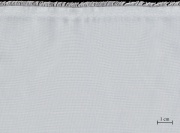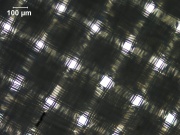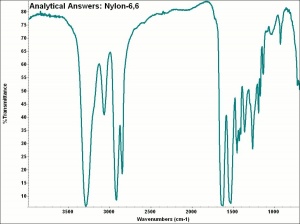Difference between revisions of "Nylon 6,6"
(username removed) |
(username removed) |
||
| Line 2: | Line 2: | ||
== Description == | == Description == | ||
| − | A polymer formed from [http://cameo.mfa.org/materials/fullrecord.asp?name=hexamethylenediamine hexamethylenediamine] and [http://cameo.mfa.org/materials/fullrecord.asp?name=adipic | + | A polymer formed from [http://cameo.mfa.org/materials/fullrecord.asp?name=hexamethylenediamine hexamethylenediamine] and [http://cameo.mfa.org/materials/fullrecord.asp?name=adipic%20acid adipic acid]. Nylon 6,6 was first made as a textile fiber in 1935 by W.H. Carothers at DuPont. It was originally given the name Fiber #66. Nylon 6,6 is very similar to [http://cameo.mfa.org/materials/fullrecord.asp?name=nylon%206 nylon 6]. The [http://cameo.mfa.org/materials/fullrecord.asp?name=thermoplastic thermoplastic] fibers are strong, tough, elastic, and have high gloss. They are extruded through a spinneret with a circular or trilobal cross section shape. Nylon monofilaments are used for brushes, surgical sutures, tennis strings, and fishing lines. Nylon 6,6 fibers are used for clothing, carpets, tire cords, conveyor belts, and brushes. They have excellent dyeability and are twice as durable as [http://cameo.mfa.org/materials/fullrecord.asp?name=cotton cotton]. Nylon is sometimes coated with plastic, such as [http://cameo.mfa.org/materials/fullrecord.asp?name=vinyl%20resin vinyl], to produce thin, lightweight waterproof fabrics. |
| − | See [http://cameo.mfa.org/materials/fullrecord.asp?name=nylon | + | See [http://cameo.mfa.org/materials/fullrecord.asp?name=nylon%20fiber nylon fiber]. |
[[File:nylon 6_6_100X.jpg|thumb|Nylon 6,6]] | [[File:nylon 6_6_100X.jpg|thumb|Nylon 6,6]] | ||
== Synonyms and Related Terms == | == Synonyms and Related Terms == | ||
| − | adipic nylon; Fiber #66; | + | adipic nylon; Fiber #66; Antron® [DuPont]; Cantrece® [DuPont]; Durasoft [Solutia]; Stainmaster [DuPont]; Wear-Dated [Solutia]; Brulon 240 [ICI]; Brulon 244 [ICI]; Perlon T [made in Germany] |
[[[SliderGallery rightalign|aaiNYLON-66.jpg~FTIR]]] | [[[SliderGallery rightalign|aaiNYLON-66.jpg~FTIR]]] | ||
| Line 31: | Line 31: | ||
== Additional Information == | == Additional Information == | ||
| − | M. Joseph, ''Introductory Textile Science'', Holt Reinhold & Winston, Fort Worth, 1986, p. 135. | + | ° M. Joseph, ''Introductory Textile Science'', Holt Reinhold & Winston, Fort Worth, 1986, p. 135. ° G.Cook, ''Handbook of Textile Fibres:II. Man-made Fibres'', 5th edition, Merrow Publishing Co., Durham, England, 1984. |
== Comparisons == | == Comparisons == | ||
| Line 50: | Line 50: | ||
== Authority == | == Authority == | ||
| − | * | + | * G.S.Brady, ''Materials Handbook'', McGraw-Hill Book Co., New York, 1971 Comment: p. 553 |
| − | * | + | * Richard S. Lewis, ''Hawley's Condensed Chemical Dictionary'', Van Nostrand Reinhold, New York, 10th ed., 1993 |
| − | * | + | * Marjory L. Joseph, ''Introductory Textile Science'', Holt, Rinehart and Winston, Fort Worth, TX, 1986 |
| − | * | + | * J.Gordon Cook, ''Handbook of Textile Fibres:II Man-made Fibres'', Merrow Publishing Co. , Durham, England |
| − | * | + | * F. Kidd, ''Brushmaking Materials'', Bristish Brush Manufacturers, London, 1957 |
| − | * | + | * Meredith Montague, contributed information, 1998 |
| − | * | + | * Website address 1 Comment: www.nswpmith.com.au/historyofplastics.html |
[[Category:Materials database]] | [[Category:Materials database]] | ||
Revision as of 06:32, 24 July 2013
Description
A polymer formed from hexamethylenediamine and adipic acid. Nylon 6,6 was first made as a textile fiber in 1935 by W.H. Carothers at DuPont. It was originally given the name Fiber #66. Nylon 6,6 is very similar to nylon 6. The thermoplastic fibers are strong, tough, elastic, and have high gloss. They are extruded through a spinneret with a circular or trilobal cross section shape. Nylon monofilaments are used for brushes, surgical sutures, tennis strings, and fishing lines. Nylon 6,6 fibers are used for clothing, carpets, tire cords, conveyor belts, and brushes. They have excellent dyeability and are twice as durable as cotton. Nylon is sometimes coated with plastic, such as vinyl, to produce thin, lightweight waterproof fabrics.
See nylon fiber.
Synonyms and Related Terms
adipic nylon; Fiber #66; Antron® [DuPont]; Cantrece® [DuPont]; Durasoft [Solutia]; Stainmaster [DuPont]; Wear-Dated [Solutia]; Brulon 240 [ICI]; Brulon 244 [ICI]; Perlon T [made in Germany]
Other Properties
Resistant to alkalis and most organic solvents. Degraded by acids and phenol. Burns with yellow-orange flame and blue smoke; smells of burnt horn. Fibers are smooth with no striations. Cross section is circular or trilobal. Tenacity = 4.6-9.0 g/denier (dry); 4.0-7.7 (wet); Elongation = 19-40% (dry); 32-46% (wet); Moisture regain = 3.8-4.5% (dry)
| Melting Point | 250 |
|---|---|
| Density | 1.14 |
| Refractive Index | 1.521; 1.547 |
Additional Information
° M. Joseph, Introductory Textile Science, Holt Reinhold & Winston, Fort Worth, 1986, p. 135. ° G.Cook, Handbook of Textile Fibres:II. Man-made Fibres, 5th edition, Merrow Publishing Co., Durham, England, 1984.
Comparisons
Properties of Synthetic Fibers
Additional Images
Authority
- G.S.Brady, Materials Handbook, McGraw-Hill Book Co., New York, 1971 Comment: p. 553
- Richard S. Lewis, Hawley's Condensed Chemical Dictionary, Van Nostrand Reinhold, New York, 10th ed., 1993
- Marjory L. Joseph, Introductory Textile Science, Holt, Rinehart and Winston, Fort Worth, TX, 1986
- J.Gordon Cook, Handbook of Textile Fibres:II Man-made Fibres, Merrow Publishing Co. , Durham, England
- F. Kidd, Brushmaking Materials, Bristish Brush Manufacturers, London, 1957
- Meredith Montague, contributed information, 1998
- Website address 1 Comment: www.nswpmith.com.au/historyofplastics.html





